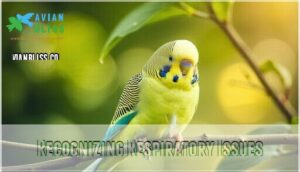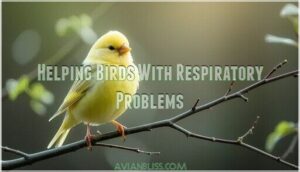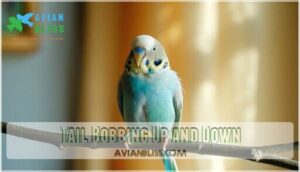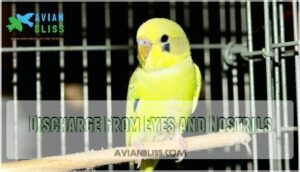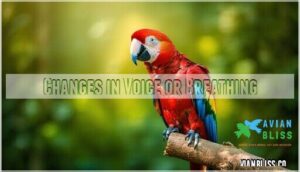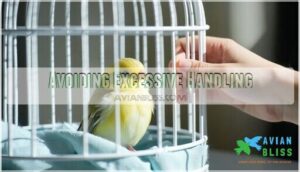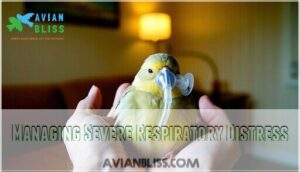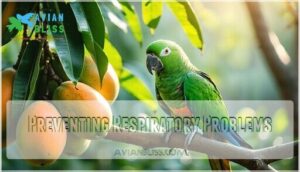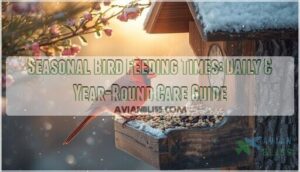This site is supported by our readers. We may earn a commission, at no cost to you, if you purchase through links.
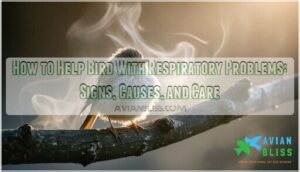
To help a bird with respiratory problems, first call an avian vet immediately—these symptoms can turn critical faster than a hummingbird’s heartbeat.
While preparing for the vet visit, move your feathered friend to a warm, quiet environment with increased humidity (a steamy bathroom works wonders).
Avoid over-the-counter medications that might do more harm than good.
Keep stress to a minimum by handling your bird gently and speaking softly.
The right environmental adjustments and professional care can make the difference between a temporary setback and a serious health crisis.
Table Of Contents
- Key Takeaways
- Recognizing Respiratory Issues
- Helping Birds With Respiratory Problems
- Common Respiratory Causes
- Signs of Respiratory Distress
- Providing Emergency Care
- Diagnostic Tests and Treatment
- Managing Severe Respiratory Distress
- Preventing Respiratory Problems
- Ongoing Care and Monitoring
- Frequently Asked Questions (FAQs)
- How to help a bird with respiratory problems at home?
- How to treat respiratory problems at home?
- Can birds recover from respiratory infections?
- What is the best treatment for a bird with respiratory distress?
- What should I do if my bird has a respiratory illness?
- Why is my bird breathing so much?
- Can a bronchodilator help birds with severe respiratory distress?
- Can avian respiratory infections be transmitted to humans?
- What is the recovery time for avian respiratory infections?
- Can stress contribute to avian respiratory infections?
- Conclusion
Key Takeaways
- If you notice signs like tail bobbing, wheezing, or nasal discharge in your bird, act quickly as respiratory issues can become critical rapidly—call an avian vet immediately while creating a warm, humid environment for your pet.
- You’ll need to minimize stress by handling your bird gently and keeping it in a quiet space during respiratory distress, as anxiety can worsen their condition and consume energy needed for recovery.
- Don’t use over-the-counter medications without veterinary guidance, as improper treatment can harm your bird—instead, focus on supportive care like proper humidity and warmth until professional help is available.
- You can prevent respiratory problems by maintaining good cage hygiene, providing proper nutrition rich in vitamin A, avoiding household toxins (especially Teflon fumes and aerosols), and quarantining new birds for 30-45 days before introduction.
Recognizing Respiratory Issues
You’ll notice your bird isn’t acting like its usual self when it struggles to breathe or makes unusual sounds while resting.
Recognizing these signs early can make all the difference in getting your feathered friend the care it needs, as early recognition is crucial.
Labored Breathing Signs
If your bird is flapping its tail excessively with each breath or you hear audible breathing sounds like wheezing, that’s a red flag.
Labored bird breathing, or dyspnea, can appear as an increased rate, gasping, or even cyanosis (a bluish tint to skin).
Watch for unusual tail movement or respiratory distress, and seek veterinary care promptly to avoid worsening bird breathing problems.
Open-Mouth Breathing Causes
Open-mouth breathing often signals serious bird breathing problems and respiratory distress.
Causes include:
- Tracheal obstruction from seeds or mucus, restricting airflow.
- Air sac pressure due to obesity, tumors, or organ enlargement compressing the avian respiratory system.
- Hypovitaminosis A, weakening respiratory tissues, increasing infection risks.
If you notice cyanosis signals (bluish skin) or labored bird breathing, contact a vet immediately—birds mask illness until it’s severe.
Annual veterinary check-ups can help in early disease detection.
Wheezing and Clicking Sounds
If you hear wheezing or clicking noises, it’s a red flag for bird respiratory problems.
These sounds often signal blocked airways or infections. The tone and frequency of the sounds can help with sound differentiation and severity assessment.
Underlying mechanisms, like environmental factors or illness, may contribute to the respiratory issues, and trying to understand these can be crucial for diagnosis.
Try home recording for your vet to analyze these respiratory symptoms.
Discharge From Nostrils
Nasal discharge in birds can be a clue to serious respiratory problems, like sinusitis or secondary infections.
Check the nares for obstruction or unusual discharge consistency. Frequent sneezing or discharge might signal hypovitaminosis A.
Keep an eye on sick bird symptoms, like labored breathing, as untreated issues could worsen. Identifying respiratory infections early prevents severe bird respiratory problems, including those that may lead to serious respiratory problems.
Helping Birds With Respiratory Problems
When your feathered friend faces avian respiratory disease, acting swiftly can make all the difference. Bird respiratory problems, like labored breathing or nasal discharge, often stem from stress, poor air quality, or infections.
Here’s how you can help. Keep stress levels low—birds hide sick bird symptoms, and a calm environment encourages recovery. Review their space; environmental control is key.
Remove potential irritants like aerosol sprays or overheated non-stick cookware, which can worsen bird respiratory infection risks. A balanced diet benefits your bird’s overall health. Provide proper nutrition to strengthen their immune system, addressing deficiencies that might complicate treatment.
If you notice signs of bird respiratory problems, like open-mouth breathing or voice changes, consult a vet experienced with avian care. Early detection is essential in treating bird illness and boosting their chances of recovery.
- Offer nutritional support with vitamin-enriched foods.
- Reduce environmental stressors like loud noises or handling.
- Follow strict quarantine protocols for new birds.
Common Respiratory Causes
Respiratory issues in birds often stem from infections, toxins, or environmental factors that disrupt their delicate breathing system.
Understanding these common causes helps you take quick action to protect your feathered friend’s health.
Bacterial Infections
Bacterial infections, such as those caused by Chlamydia psittaci and Gram-negative organisms, often lead to bird respiratory infections.
Gram-positive flora like Streptococcus can also play a role. Secondary infections are common if left untreated.
A proper bacterial diagnosis guarantees targeted antibiotic treatment, key to recovery.
Quick action prevents complications, offering your feathered friend the care they need to breathe easily again.
Viral Infections
Viral infections, like Avian Influenza and Herpesvirus Transmission, can cause serious bird respiratory problems.
Symptoms might include sneezing, coughing, or nasal discharge. Adenovirus Symptoms can mimic other avian diseases, while Paramyxovirus Effects often worsen breathing.
Poxvirus Infections may impact both wild and pet birds. Quick bird treatment with a vet guarantees no feathered friend becomes a carrier of these respiratory infections, ensuring a healthy outcome.
Fungal Infections
Fungal infections, like aspergillosis, often stem from Aspergillus sources such as damp feed or poor ventilation.
Birds may suffer chronic infections or acute dyspnea when spores overwhelm their system.
Candida can also affect the respiratory tract, causing sneezing or discharge.
Treating these requires antifungal drugs, and antifungal therapy is essential.
Avoiding zoonotic transmission means keeping environments clean and well-ventilated.
Air Sac Mites
Air sac mites wreak havoc in small birds like finches, causing wheezing, open-mouth breathing, and serious bird respiratory problems.
These pests sneak through nostrils, completing their mite life cycle quickly.
Diagnosis challenges mean an avian vet specialist is essential, and treatment options like ivermectin or other antiparasitic drugs work well if caught early.
Preventative measures, including hygiene and isolating infected birds, are essential.
Inhaled Toxins
It’s surprising how common inhaled toxins harm birds.
PTFE toxicity from overheated Teflon cookware, smoke inhalation, and aerosol dangers can cause sudden respiratory distress or death.
Birds’ highly efficient lungs make them incredibly sensitive to airborne toxins and poor air quality.
Prevent exposure by keeping your bird away from fumes, aerosols, and cooking areas to guarantee a safe environment and reduce the risk of sudden respiratory distress.
Signs of Respiratory Distress
If your bird is showing unusual signs like tail bobbing, open-mouth breathing, or strange clicking sounds, it could be experiencing respiratory distress.
Recognizing these symptoms early can make a huge difference in getting your feathered friend the help it needs, which is why early recognition is crucial.
Tail Bobbing Up and Down
When you notice tail bobbing, it’s a clear sign your bird is struggling to breathe.
This rhythmic motion indicates labored breathing, often caused by serious respiratory signs.
Think of it as your bird working overtime to push air through its system, which is not just discomfort—it’s a severity indicator and points to underlying causes needing immediate attention.
This can be triggered by respiratory or heart issues.
Stretching The Neck Out
Your bird’s neck stretching is a critical sign of respiratory distress that demands immediate attention. When birds struggle to breathe, they extend their necks to maximize airway flow.
- Neck stretching mechanics help birds compensate for airway obstruction
- Pain management becomes necessary as muscle spasms develop
- Underlying conditions like aspergillosis or bacterial infections often cause this behavior
- Birds may alternate between normal posture and extended neck positions
- Labored breathing (dyspnea) typically accompanies this distressing symptom, which can be a sign of serious health issues.
Discharge From Eyes and Nostrils
While neck stretching indicates respiratory effort, discharge from your bird’s eyes and nostrils is an equally concerning sign.
Clear, cloudy, or thick nasal discharge often signals sinusitis or secondary infections. Hypovitaminosis A commonly contributes to these symptoms by weakening respiratory tract defenses.
You’ll notice crusty material around nares that may cause blockage. Wipe away discharge gently with a warm, damp cloth, but remember – persistent bird respiratory symptoms require veterinary attention, as they frequently indicate serious avian respiratory diseases.
Changes in Voice or Breathing
Beyond discharge issues, you’ll notice significant changes in your bird’s voice or breathing patterns when respiratory problems develop.
Listen for hoarseness, squeaking, or complete voice loss.
Watch for increased respiratory rate, unusual breathing sounds like wheezing or clicking, and labored breathing efforts.
In severe cases, cyanosis signs (bluish coloration) may appear around the beak or tongue, indicating oxygen deprivation—an immediate emergency requiring veterinary care.
Providing Emergency Care
When your bird shows signs of respiratory distress, you’ll need to act quickly with appropriate emergency care to improve their chances of recovery.
You can provide immediate help by creating a warm, humid environment and minimizing stress while arranging transportation to an avian veterinarian.
Keeping The Bird Warm and Quiet
Immediately after noticing bird respiratory problems, create a quiet environment by moving your pet bird to a warm, draft-free area.
You’ll want to place the hospital cage away from household traffic and noise, as stress reduction is essential for recovery.
Cover three sides of the cage for nighttime comfort, maintaining a consistent temperature of 85-90°F, which enables heat therapy to help birds conserve energy they’d otherwise use staying warm while fighting illness, and this is crucial for their overall recovery.
Providing Oxygen and Humidity
You’ll need to create a humid environment for your distressed bird.
Place a humidifier near the cage or create a makeshift oxygen tent using a clear plastic container with air holes.
For immediate respiratory support, run a hot shower to create steam in your bathroom.
Consider using a specialized oxygen concentrator for birds needing extra support, as some avian veterinarians recommend nebulization benefits for medication delivery directly to the respiratory system during emergencies, which can provide oxygen-rich support.
Gently Wiping Away Discharge
While providing humidity, you’ll likely notice discharge around your bird’s eyes or nostrils.
Gently wipe away this material using a soft, damp cloth or cotton swab. The discharge consistency can indicate underlying causes—clear indicates allergies, while yellow or green suggests infection.
Use safe techniques by moving from the eye outward, preventing irritation. Never use home remedies like oils or creams, as they can worsen bird respiratory problems.
Clean the bird cage thoroughly afterward to prevent the spread of disease.
Avoiding Excessive Handling
When your bird shows respiratory distress, minimize handling to reduce stress.
Birds use a lot of energy to appear normal—additional handling can worsen their condition.
For observational care:
- Watch from a distance, noting breathing patterns without disturbing the cage
- Use gentle approaches when necessary, such as quick cage cleaning
- Maintain a quiet environment with limited visitors around the bird’s area
Trust building comes later, after recovery begins.
Diagnostic Tests and Treatment
When you notice your bird struggling to breathe, you’ll need proper diagnostics and treatment to identify the exact cause and restore their health.
Your avian veterinarian will use specialized tests like blood work, X-rays, and microscopic examinations to determine whether bacteria, fungi, or environmental toxins are behind your feathered friend’s respiratory distress.
Physical Examination
After stabilizing your bird in an emergency situation, the veterinarian will perform a thorough physical examination to identify the underlying cause of respiratory distress.
During a clinical examination, your vet will assess several key areas to evaluate your bird’s respiratory health.
The examination will include the following areas:
| Examination Area | Technique | Normal Findings | Abnormal Signs |
|---|---|---|---|
| Nares & Sinuses | Sinus palpation | Clear, dry openings | Discharge, swelling |
| Oral Cavity | Visual inspection | Pink mucosa, normal choanal slit | Plaques, inflammation |
| Chest | Auscultation findings | Clear air movement | Crackles, wheezing |
| Abdomen | Crop palpation | Soft, pliable | Distension, masses |
Your vet will also evaluate feather quality and breathing patterns, considering the unique avian respiratory tract anatomy during the diagnostic approach.
Radiographs and Endoscopy
After a thorough physical exam, your veterinarian might recommend advanced imaging.
Radiographs provide a window into your bird’s respiratory system, revealing issues like bronchopneumonia or air sac thickening.
For more detailed airway evaluation, endoscopy offers direct lesion visualization, especially useful for identifying foreign bodies or fungal growths.
While radiographs show the big picture, endoscopic procedures allow veterinarians to see inside the trachea and air sacs, offering precise diagnosis for respiratory problems.
Microscopic Examination
A close-up look under the microscope gives your veterinarian vital clues about what’s affecting your bird’s respiratory system.
This detailed examination reveals the invisible culprits behind breathing difficulties.
- Sample preparation techniques vary depending on whether it’s a sinus aspirate, biopsy, or tracheal/lung lavage
- Cytology analysis requires special stain techniques to highlight different cellular structures
- Microscopic findings may reveal bacteria, fungi, or inflammatory cells
- Identifying pathogens directly guides treatment choices
- Sinus flush samples often contain evidence of vitamin A deficiency alongside infections
Antibiotics and Antifungals
After your vet identifies the specific pathogen from microscopic examination, they’ll prescribe appropriate medications.
You’ll likely need antibiotics for bacterial infections or antifungal drugs for fungal problems like Aspergillosis.
Treatment duration typically lasts 2-6 weeks depending on severity.
Never buy bird antibiotics online without a prescription—improper dosage calculation can lead to antibiotic resistance or dangerous drug interactions.
Antifungal therapy may have side-effects, so follow your vet’s instructions carefully when treating respiratory problems.
Managing Severe Respiratory Distress
When your bird shows signs of severe respiratory distress, you’ll need to act quickly with oxygen support and a stress-free environment to improve their chances of survival.
You can’t afford to wait during these critical moments, as immediate veterinary care coupled with careful monitoring will make all the difference for your feathered friend.
Inhalation of Airborne Toxins
After diagnostic testing reveals the cause, treatment must be swift.
Birds are extremely sensitive to airborne toxins in your home. Overheated Teflon (PTFE) cookware releases deadly fumes that can kill birds within minutes.
Smoke inhalation, aerosol exposure, air fresheners, and candle fumes are equally dangerous. If you suspect your bird has inhaled environmental toxins, remove them from the area immediately and rush to an avian veterinarian—every second counts.
Administering Bronchodilators
During severe respiratory distress, bronchodilators can be a lifeline for your feathered friend.
These medications help relax airway muscles and improve breathing.
Nebulization delivers medication directly to the lungs with minimal side effects, while injections may be necessary for critical cases.
When administering bronchodilators, carefully calculate dosage based on your bird’s species—African greys are particularly sensitive to certain medications.
Always monitor your bird’s response throughout treatment.
Anesthesia and Reduced Anxiety
While bronchodilators help open airways, anesthesia may be necessary for birds in severe respiratory distress.
Veterinarians carefully select drugs based on your bird’s condition to minimize respiratory depression. Stress reduction is critical—birds with anxiety disorders often worsen when handled.
Your vet will implement strict monitoring protocols during procedures and may recommend a hospital cage with oxygen therapy for post-op care.
Some avian specialists also teach nebulizing birds at home for ongoing respiratory support, which can be crucial for birds with severe respiratory issues, and provide a means of stress reduction.
Improving Survival Rates
To pull your bird through respiratory distress, early intervention is essential.
Early intervention saves lives—act swiftly to give your bird the breathing room it needs to recover and thrive.
Providing supportive care while reducing stress substantially improves survival rates.
Warm, oxygen-rich environments coupled with proper nutrition enhance recovery chances.
Advanced treatments like nebulization therapy can deliver medications directly to affected areas.
Owner education about recognizing early symptoms leads to faster treatment.
Remember, avian respiratory problems require swift attention – every minute counts when your feathered friend can’t breathe properly, and this is a matter of life.
Preventing Respiratory Problems
You’ll save your feathered friend from distress by taking proactive steps to prevent respiratory problems before they start.
Creating a clean, toxin-free environment and providing proper nutrition rich in vitamin A will substantially strengthen your bird’s respiratory defenses against potential infections and illness, which helps to prevent distress by taking proactive steps.
Avoiding Exposure to Toxins
Numerous household items pose serious dangers to your bird’s respiratory system.
Keep birds far from overheated Teflon (PTFE) cookware, which releases deadly fumes. Avoid smoking indoors, as birds are extremely sensitive to smoke exposure.
Never use aerosol sprays near birds—these products contain chemicals that damage delicate lungs.
Monitor air quality and learn to identify common toxins like polytetrafluoroethylene. Your vigilance in preventing toxic exposures could save your feathered friend’s life.
Maintaining Good Hygiene
Beyond avoiding toxins, keeping your bird’s environment clean is your next defense against respiratory issues.
Regular cage cleaning prevents harmful bacteria and fungal growth.
Wipe down perches weekly and disinfect food and water dishes daily.
Maintain fresh water and properly store bird food to prevent mold.
Good air quality through proper ventilation supports bird immunity.
Using a proper bird cage cleaner can further reduce risks.
Even small cleaning habits make a big difference in preventing respiratory diseases in your feathered friend.
Quarantining New Birds
Quarantining new birds creates a essential safety barrier against respiratory infections spreading through your avian family. Always isolate newcomers for 30-45 days before introduction.
- Set up the quarantine cage in a separate room with good ventilation but away from existing birds
- Monitor daily for respiratory symptoms like tail bobbing or nasal discharge
- Schedule a vet check during isolation for disease screening
This practice substantially reduces transmission risks while supporting bird immunity. Quarantining is a critical step in protecting your birds’ health.
Providing Proper Nutrition
While quarantine protects birds from contagion, proper nutrition forms your first line of defense against respiratory issues.
Proper bird nutrition substantially impacts respiratory health, particularly through vitamin A levels. All-seed diets often lack this essential nutrient, weakening the immune system. A balanced diet is key to preventing nutritional deficiencies.
| Nutrient Source | Benefits | Daily Amount |
|---|---|---|
| Orange vegetables | High vitamin A | 1-2 teaspoons |
| Pellet foods | Balanced nutrition | 70% of diet |
| Leafy greens | Immune support | 1 tablespoon |
Support your bird’s immunity by gradually converting from seed diets to pellets, supplementing with fresh foods daily, and focusing on balanced nutrition to ensure overall health and respiratory health.
Ongoing Care and Monitoring
You’ll need to maintain vigilant monitoring of your bird’s health after respiratory treatment, watching for any returning symptoms like tail bobbing or nasal discharge.
Regular veterinary check-ups and immediate attention to changes in breathing, appetite, or behavior will substantially improve your feathered friend’s chances of full recovery.
Yearly Exams and Check-Ups
Prevention is your best defense against respiratory issues in birds.
Schedule yearly check-ups with an avian veterinarian to maintain your bird’s respiratory health. These regular exams establish important health baselines that make early detection possible.
During these annual visits, your vet will:
- Perform thorough physical assessments focusing on respiratory function
- Update vaccinations and preventative treatments as needed
- Discuss any behavioral changes that might indicate developing problems.
Regular check-ups catch subtle issues before they become serious, giving your feathered friend the proactive care they need to stay healthy, and this is crucial for their overall well-being, especially in terms of respiratory health, which can be maintained through yearly check-ups, and supported by preventative treatments.
Monitoring for Signs of Illness
With a keen eye, you’ll catch bird respiratory problems early.
Watch for subtle symptoms like changes in breathing patterns, decreased activity, or unusual silence.
Birds often hide illness, so monitor their appetite, droppings, and feather condition daily.
Listen for voice changes or mild clicking sounds when they breathe.
Remember, even slight behavioral changes can signal respiratory issues requiring immediate attention.
Adjusting Diet and Environment
While watching for illness signs, don’t overlook your bird’s environment and diet. Both play major roles in preventing respiratory issues. Your pet birds need proper nutrition—especially vitamin A—and clean surroundings to maintain healthy respiratory systems.
For ideal air quality and bird immunity, consider:
- Replacing seed-only diets with pellets and fresh vegetables
- Installing air purifiers to remove airborne particles and toxins
Consider using a specialized purifier model for your bird.
- Maintaining stable temperature control (avoid drafts and sudden changes)
- Implementing weekly deep cleaning bird cage practices beyond daily spot cleaning to ensure clean surroundings and support bird immunity with a focus on proper nutrition.
Seeking Veterinary Care Promptly
Don’t wait until your bird’s breathing troubles reach a crisis point.
Contact an avian veterinarian at the first sign of respiratory distress, as birds can deteriorate rapidly.
Delay consequences can be fatal, while prompt veterinary care substantially improves survival rates.
Your avian specialist will discuss treatment options based on diagnosis and develop a follow-up care plan to monitor recovery and prevent recurrence.
Frequently Asked Questions (FAQs)
How to help a bird with respiratory problems at home?
Move your bird to a clean, warm environment with humidity.
Remove potential toxins and irritants.
Offer fresh water and nutritious food.
Contact an avian vet immediately, as respiratory issues require professional care.
How to treat respiratory problems at home?
Provide veterinary-grade humidity, clean air, and warmth immediately.
Remove potential toxins, upgrade to a pelleted diet, and reduce stress.
However, respiratory issues require professional care—these measures only support while seeking veterinary treatment.
Can birds recover from respiratory infections?
Like phoenixes rising from the ashes, birds can indeed recover from respiratory infections with proper veterinary care.
Your feathered friend’s recovery depends on early treatment, the specific infection type, and their overall health condition.
What is the best treatment for a bird with respiratory distress?
Seek immediate veterinary care while keeping your bird warm and stress-free.
You’ll need oxygen therapy, appropriate medications (antibiotics or antifungals), and removal from potential toxins.
Nutritional support and proper humidity are also essential.
What should I do if my bird has a respiratory illness?
Take your bird to an avian vet immediately.
Meanwhile, keep them warm, reduce stress, make certain good ventilation, and remove potential toxins.
Don’t try home remedies without professional guidance. Time is critical.
Why is my bird breathing so much?
Like canaries in coal mines, birds signal danger through rapid breathing.
Your bird may be stressed, sick, or exposed to toxins.
Respiratory infections, heart issues, or overheating often cause increased breathing rates.
Can a bronchodilator help birds with severe respiratory distress?
Bronchodilators can help birds with severe respiratory distress, but they must be prescribed by an avian veterinarian.
Dosage is species-specific and administration requires professional guidance due to birds’ unique respiratory system.
Can avian respiratory infections be transmitted to humans?
Yes, some avian infections can jump species.
Chlamydophila psittaci is the most concerning, causing psittacosis in humans.
You’ll need immediate medical attention if you develop flu-like symptoms after exposure to an infected bird.
What is the recovery time for avian respiratory infections?
Recovery time for avian respiratory infections varies widely – from 2-3 weeks for minor cases to several months for severe conditions like aspergillosis.
Your bird’s recovery depends on the specific infection, prompt treatment, and overall health.
Can stress contribute to avian respiratory infections?
While birds naturally hide vulnerability, stress can substantially compromise their immune system.
You’ll find that anxious environments, improper handling, or sudden changes weaken your bird’s defenses, making them more susceptible to respiratory infections.
Conclusion
Will you ever face a feathered friend in respiratory distress?
By knowing how to help a bird with respiratory problems, you’re prepared for this scary situation.
Remember, quick action with veterinary care, a warm environment, and stress reduction can save your bird’s life.
Stay vigilant for tail bobbing, wheezing, or discharge, and maintain proper cage hygiene to prevent future issues.
Your swift response and ongoing care will keep your avian companion breathing easily for years to come.

